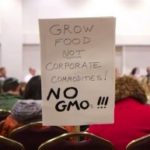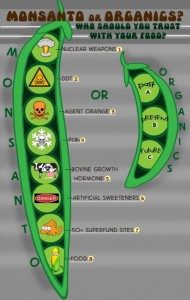Archive for November, 2011
GMOs in the News

GMOs in the News – November 2011
Hope everyone had a Happy Thanksgiving – Mom
The good new is that the California Ballot initiative has been filed and we should be ready to start gathering signatures In early January. If you are in California, please join us – even a few hours a month – to help gather signatures from January thorough April. If you are not in California and want GMOs labeled – please donate! Even $5 will make a difference. And getting GMOs labeled in CA will get them labeled for everyone in the US. Companies are not going to have separate labels for one state.
Here’s the donation link: http://www.labelgmos.org/?recruiter_id=958
How much insecticide do Bt plants actually produce?
New publication shows inadequacies in risk assessment
TestBiotech (Munich), 21 November 2011
http://www.testbiotech.de/en/node/578
A new publication by an international research consortium has revealed several inadequacies in current approaches to risk assessment of genetically engineered plants. The publication deals with methods used for measurement in so-called Bt-plants. These plants produce an insecticidal protein (a so-called Bt toxin) that originates from soil bacteria (Bacillus thuringiensis). One example is maize MON810 which is cultivated in some countries in the EU, many others can be imported and used in food and feed. Now for the first time, joint research involving four laboratories has shown that the results produced by industry and other institutions so far are not reliably reproducible and comparable because they are not determined and validated by standardized methods.
The actual content of these Bt toxins is highly relevant for assessing risks for the environment, and also for preventing resistance in pest insects. Without reliable data, the safety of these genetically engineered plants cannot be properly assessed.
András Székács from the Plant Protection Institute of the Hungarian Academy of Sciences summarized relevant findings: “Our data emphasize the importance of standardized protocols among laboratories and provide compelling evidence that, currently, reproducibility and comparability of reported Bt toxin measurements is low. Hence, individual results of Bt toxin concentrations cannot be taken at face value as a definitive result without further validation. An outstanding example is the reporting of Bt concentrations in pollen of MON 810 maize, stemming from very few individual studies only.”
The content of Bt toxin in pollen is a pivotal question when it comes to environmental risk assessment and regulatory decision-making. The pollen can be taken up by various pollinating insects such as honey bees and wild bees, hoverflies and many more. It can also be ingested by butterfly caterpillars that feed on pollen-dusted plants. Toxic pollen is extremely rare in nature but has become wide-spread where genetically engineered Bt-plants are grown. Of similar importance is the Bt content in roots since it might affect important soil organisms and their food web. But also the Bt content in those parts of the plants that are used for food and feed is critical since open questions remain concerning their potential effects on health. Additionally, only very little research has investigated the impact of various environmental factors on the Bt toxin production in different Bt plant varieties and plant parts. Thus, reliable methods for measuring Bt concentrations in Bt plants that can be compared among studies are indispensable and urgently needed.
Read the rest here: http://gmwatch.eu/index.php?option=com_content&view=article&id=13513:how-much-insecticide-do-bt-plants-produce
Boulder Citizens Say No to GMOs, Will the Commissioners Listen?
By Matt Spaeth on November 16, 2011
In Boulder, CO, the fight to keep GMOs off county lands is entering the final rounds. After months of deliberation, an agricultural policy group has recommended that GMOs be allowed on open space land and the people of Boulder county are making sure their leaders know they do not approve. Their message is being heard and the collective thorn is growing in Monsanto’s side. Will the county commissioners side with the corporations or the people?
The joint session of the Food and Agriculture Policy Council (FAPC) and the Parks and Open Space Advisory Commission (POSAC) saw a huge turnout Tuesday night at the Longmont Convention Center. The purpose of this meeting was to publicly present and receive comments on the current agricultural policy recommendations set forth by the members of the Cropland Policy Advisory Group (CPAG). The Boulder Cropland Policy encompasses many aspects of agriculture, but the main issue is whether to let farmers grow GMO crops on public open space land. While this group could not come to a consensus on the GMO issue, the majority of the members recommended that GMOs be allowed on open space land.
Boulder, known for its progressive stance on sustainability and the environment, naturally attracts more health-oriented people than the national average. Local surveys have shown that 71% of the people do not approve of GMOs being grown on county land. Proponents for both sides of the issue were in attendance, but the crowd’s reaction to the meeting’s proceedings made it overwhelmingly clear who was the majority. Concerned citizens arrived carrying posters and the applauses for non-GMO statements were so long and numerous, the facilitator requested they be withheld.
Each citizen was given three minutes to speak. The vast majority expressed their concerns about the safety of GMO crops, their associated chemical application, and possible contamination issues. They spoke out against the conflict of interest, political influence and corporate greed that has affected national GMO public policy.
Members of the Boulder GMKnow Group, a local non-GMO awareness group organized by Scott and Mary Smith, were not satisfied with the recommended agricultural policy and wrote their own. This new policy, called the Citizens Cropland Policy was read by 25 members in 3-minute intervals and is available for viewing and endorsement on their website.
The opposite camp showed up as well. Standing out like sore thumbs, the large men, wearing blazers and cowboy hats, stood mostly in the back of the room. Their arguments were that GMOs made it easier for them to make more money.
During the public comments, an unidentified man in red shirt, who expounded on the benefits of GMOs to the panel, was later questioned as to his affiliations by an elderly man in the crowd. The red-shirted man pushed the elderly man and told him to “sit down”. It was later revealed to the panel that the red-shirted man is a Monsanto employee.
Read the rest here: http://foodintegritynow.org/2011/11/16/boulder-citizens-say-no-to-gmos-will-the-commissioners-listen/
Read more, great Monday Mania Posts here: http://www.thehealthyhomeeconomist.com/2011/11/monday-mania-11282011/
Read more, great Real Food Wednesday posts here: http://kellythekitchenkop.com/2011/11/real-food-wednesday-11302011.html
Read more, great Simple Lives Thursday posts here: http://gnowfglins.com/2011/11/30/simple-lives-thursday-72/
Thanksgiving Moneybomb for GMO Labeling
| Here’s a great way to show your thanks for the GMO labeling ballot initiative – Pledge $5 for Thanksgiving! Mom |
|
|
||||||||||||||||||
![]()
Grain Free French Toast

I found the original recipe in a low carb cookbook. It looked good and is pretty easy too. It makes enough to either serve two to three people or for a few days of leftovers.
Ingredients:
4 large, organic, pastured eggs
½ cup full-fat Ricotta cheese
¼ cup organic heavy cream, preferable raw
2 tbs. Rapadura or Organic Sugar (I use ½ tsp Stevia)
½ tsp. Cinnamon
½ tsp. Nutmeg
1 tsp. coconut oil or butter for frying
Directions:
Preheat the oven to 350° F. Coat an 8×8–inch baking dish with coconut oil or butter.
Mix everything except the oil together, and pour the mixture into the oiled baking dish.
Bake for 20-30 minutes – it’s closer to 30 minutes for me usually – until a knife inserted in the middle comes out clean. Let cool and then cut into quarters.
Heat the oil or butter in a frying pan and fry the four pieces until they’re brown on both sides. Serve with your favorite topping. Enjoy!
Read more, great Monday Mania posts here: http://www.thehealthyhomeeconomist.com/2011/11/monday-mania-11212011/
Read more, great Fat Tuesday posts here: http://realfoodforager.com/2011/11/fat-tuesday-novermber-22-2011/
Read more, great Real Food Wednesday posts here: http://kellythekitchenkop.com/2011/11/real-food-wednesday-11232011.html
Read more, great Simple Lives Thursday posts here: http://gnowfglins.com/2011/11/23/simple-lives-thursday-71/
Read more, great Fight Back Friday posts here: http://www.foodrenegade.com/fight-back-friday-november-25th/
A Parent’s Guide to GMOs

A Parent’s Guide to GMOs and the Ballot Initiative
This is from a great brochure created by one of the people working on the campaign – let’s pass this along to all the moms we know and get the word out! Hope you have a great week. – Mom
Given the questions, we have a right to know what’s in our foods.
Stand with us. Join us to require integrity in food labeling.
What are GMO’S
Genetically Modified organisms, often called genetically engineered (GE). The correct scientific term is “transgenics.” This is a process whereby the genes of one species are inserted into another species. For the purposes of this initiative, the term does not include hybrids, selective breeding, grafting or MAS (Marker Assisted Selection)
What’s your Rush?
New studies point to increased health risks. Numerous vegetables, fruits and animal products are being developed and considered for approval. We are concerned with the recent deregulation of the high cross pollinator, alfalfa. We want to do all we can to ensure our children have the option of organic dairy and meats.
What has changed?
In the last 15 years, novel proteins, allergens and toxins have been introduced into the American food supply in order to enhance profitability for the food industry. No human trials were ever conducted to assess the safety of these chemicals on children, leading other developed countries to take a precautionary approach and these ingredients were not introduced into the food supplies in other developed countries. Increasing scientific evidence continues to demonstrate the impact that these chemicals are having on our health and particularly on the health of our children, their developing immune systems, nervous systems and gastrointestinal and digestive systems (in which 70% of a child’s immune systems is found).
Our Intimate Relationship with Food
In 1996, the United States adopted widespread use of genetically modified crops due to growing public concern over the health risks associated with the industrial spraying of insecticidal and pesiticidal toxins.
In an effort to reduce the spraying of these toxins, scientists began using biotechnology to engineer these pesticides and insecticides into the plants themselves.
As a result, chemical use has increased to an extreme amount of around 180 million more pounds per year being used.
As these ingredients were introduced around the world ten years ago, government agencies in Europe, Asia, Australia, Japan, Russia and over 30 developed countries required them to be listed on food labels, so that consumers could make informed choices when it came to feeding their families.
In the United States, our regulatory agencies do not require these genetically engineered ingredients to be labeled.
So, unlike other developed countries, we have not been informed that almost 70% of our corn, 90% of our soy and 75% of our processed food now contain neurotoxins, novel proteins and allergens.
Today one out of every three children suffers from allergies, asthma, autism or ADHD. It appears that we have unknowingly and without informed consent engaged our children in one of the largest human trials in history.
Ten years into this human trial, our children are trying to tell us something.
Shouldn’t we listen?
Worldwide Labeling
There are over 40 countries who require labeling of GMO’s. Many US companies sell them GMO-free versions of products sold in the US that contain them.
Number of Crops Worldwide
USA: Soy/93%, Corn 86%, Cotton 93%, Papaya 80%, Canola 93%, Zucchini 13%, Sugar beets (which can be listed as ‘sugar’ in any processed food) 95%
Why do we want them Labeled:
The main reason we want them labeled is that we see enough independent data to suggest possible health risks. We don’t want to eat them but we can’t know which foods they are in if they aren’t labeled. It’s a basic consumer right we are asking for– given the conflicting data and our mistrust in an industry that has been proven to hide negative findings, we have the right to know what we are buying and putting in our children’s mouths.
The Initiative
A grassroots movement to get an initiative that would require mandatory labeling of genetically modified food.
In the U.S., 24 states have an initiative process. What this means is that if the people want a law and they cannot get their legislators to enact it, the people can come together and get the law on the ballot to vote for it directly.
It’s time to send a strong, direct message to those who govern us, whether it be agency or elected, that we want genetically engineered foods labeled.
What can we do now?
Spread the word: Tell everyone you know. Especially everyone who lives in California.
Volunteer: If you live in CA: Sign the Pledge to gather Signatures for this Fall.
Join the Team: Visit the site to see what we want to create and if you see yourself wanting it.
Donate: We are a grassroots movement and need everyone’s support. Initiatives are very expensive. Those who want to see a labeling vote fail have tremendous resources to try and silence us. If you’re not in California, please donate! Even a few dollars will make a difference and getting labeling here will make it happen for the whole country.
Learn more at the links below
2012 Ballot Initiative Campaign Website:
You can also become part of our Facebook page to get the latest details and updates for our Community. https://www.facebook.com/labelgmos
Read more, great Monday Mania posts here: http://www.thehealthyhomeeconomist.com/2011/11/monday-mania-1172011-2/
Read more, great Fat Tuesday posts here: http://realfoodforager.com/2011/11/fat-tuesday-november-8-2011/
Read more, great Real Food Wednesday posts here: http://kellythekitchenkop.com/2011/11/real-food-wednesday-11092011.html
Read more, great Pennywise Platter Thursday posts here: http://www.thenourishinggourmet.com/2011/11/pennywise-platter-thursday-1110.html
Read more, great Simple Lives Thursday posts here: http://gnowfglins.com/2011/11/09/simple-lives-thursday-69/
Read more, great Fight Back Friday posts here: http://www.foodrenegade.com/fight-back-friday-november-11th/





